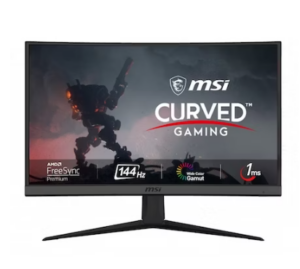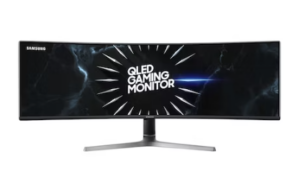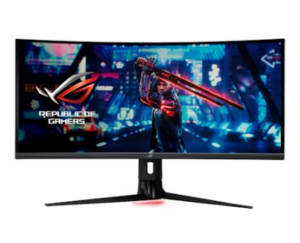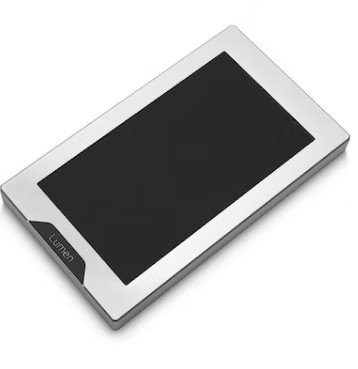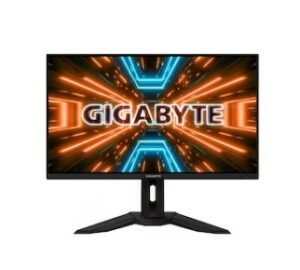Refresh rates, resolution, and panel type – when it comes to selecting the perfect gaming monitor there are countless options, variants, and features to look out for. It’s enough to make it feel like your head is about to explode!
Thankfully, here at Overclockers UK, we’ve compiled all our expert knowledge about gaming monitors into this handy guide. We’ll be highlighting why you should buy a gaming monitor, the different panel types and screen sizes, key features, along with our top recommendations.
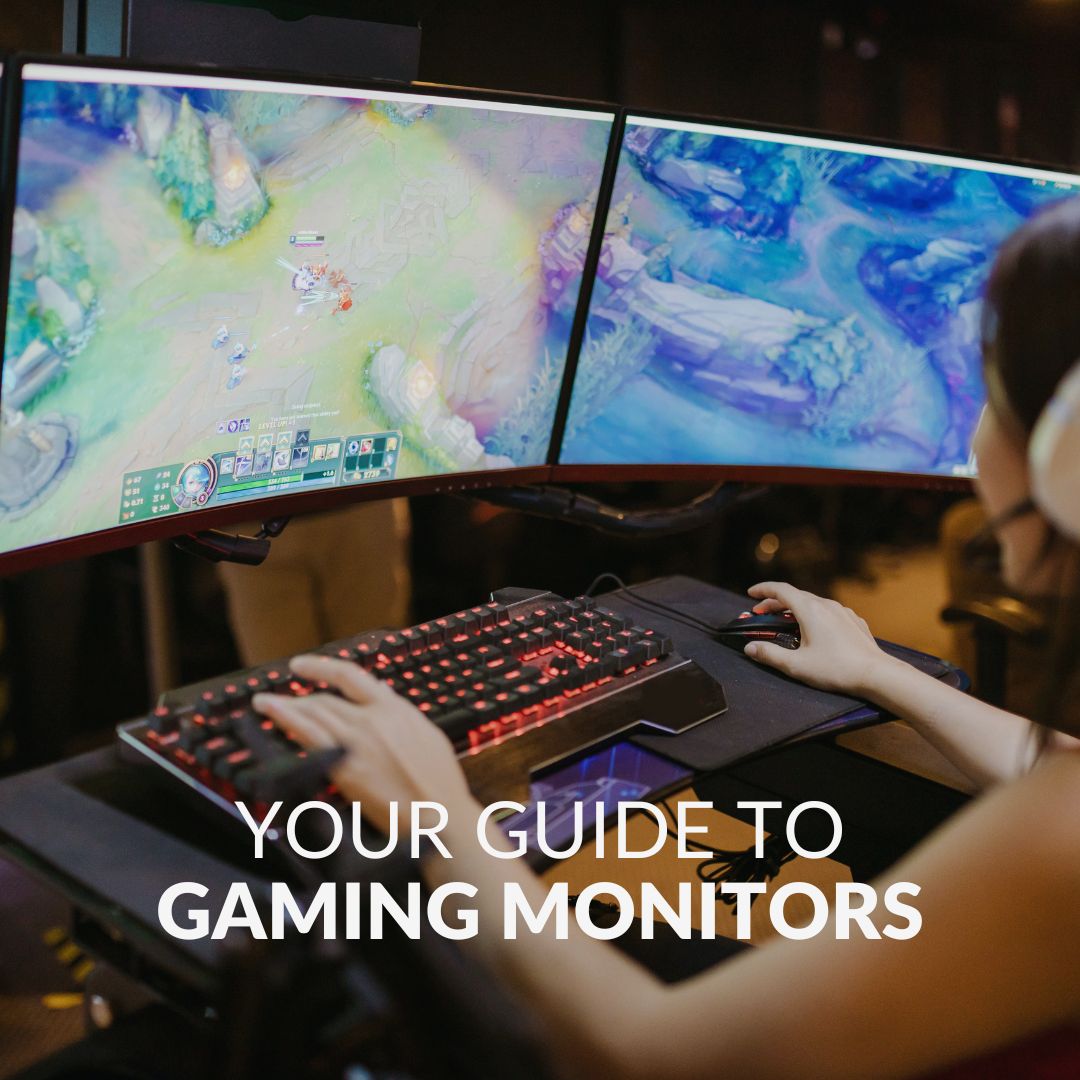
Why Buy a Gaming Monitor?
A high-quality gaming monitor is a must for any set up. Without one you won’t be able to enjoy playing your favourite games or watching the latest viral video.
What sets a gaming monitor apart from your standard monitor is the vast array of options available. From panel types, to different resolutions and sizes, as well as cutting-edge built-in features, gaming monitors have been fine-tuned to deliver exceptional graphics, smooth frame rates, fast response times, and much more. All of which optimise performance in both work and play!
What’s more, a gaming monitor also features premium adjustability that allows you to optimise the ergonomics of your set up. The top of your monitor needs to be positioned at or slightly just below your eye level. With a gaming monitor, you can often adjust the height, swivel, and tilt to ensure it is situated in the perfect position to reduce strain on your eyes and neck.
Key Features of a Gaming Monitor
What you look for in a gaming monitor all depends on your individual preferences. However, we’ve highlighted a few of the key features to look out for.
Panel Type:
There are six different panel types, each with their own set of characteristics, advantages and disadvantages.
- TN
- IPS
- VA
- OLED
- TFT
- LCD
TN:
A TN (Twisted Nematic) panel utilises liquid crystal technology with two filters placed vertically and horizontally. TN monitors are best suited to those on a budget, since they often offer high refresh rates and response times at a wallet-friendly price.
IPS:
A monitor with an IPS (In-Plane Switching) panel is typically more expensive, however it is the perfect choice for gamers, streamers, and creative professionals due to its high refresh rates and colour accuracy.
VA:
A VA (Vertical Alignment) panel combines features of both TN and IPS into one. Offering high-quality refresh rates, response times, wide viewing angles, and greater colour accuracy.
OLED:
OLED monitors utilise Organic Light Emitting Diodes to completely remove the need for a backlight or sidelight, which are commonly found in traditional monitors. These diodes illuminate the pixels on your screen, for high-quality visuals, refresh rates, and stunning colour accuracy.
TFT:
TFT (Thin-Film Transistor) monitors utilise transistors as individual pixels to offer greater response times, refresh rates, and vivid colours. All of which makes these monitors perfect for gamers, streamers, and content creators.
LCD:
LCD monitors take advantage of built-in liquid crystals to illuminate each pixel in stunning quality. These monitors come equipped with a vast array of features that are sure to boost your performance in both gaming and work. This includes fast response times, high refresh rates, and colour accuracy.
Size and Resolution:
It’s crucial you select a gaming monitor that is the perfect size for both your individual preferences and your set up. If you have a small office space, it’s not the greatest idea to purchase a hefty monitor that will barely fit on your desk… The size of your screen relates to how big it is in inches, whilst the resolution all depends on the number of pixels, which is measured in pixels per inch (PPI).
Having a monitor with a high resolution comes with a multitude of benefits. All your images, videos, and gaming landscapes will be displayed in stunning high-res with exceptional detail. What’s more, a higher resolution means you can have more tabs and applications open on your screen at once. This is a huge boost to productivity since you can view more than one window at a time.
The most common gaming monitor sizes and resolutions include:
- 24 inches – 1920 x 1080
- 27 inches – 2560 x 1440
- 32 inches – 3840 x 2160
- 34 inches – 3440 x 1440
Ultrawide:
An ultrawide monitor is ideal for both gaming and work. These monitors typically feature an 21:9 aspect ratio which grants you a huge viewing angle for greater immersion. Plus, hefty resolutions, such as 3440 x 1440, makes them perfect for boosting your productivity and multitasking. No more constantly flicking between multiple tabs and applications!
Curved:
A curved monitor has been designed to match the curvature of the human eye, offering a wider field of view and aspect ratio. This makes them perfect for fans of FPS, competitive esports, and RTS titles, since the wider viewing angle means you can see more of the gaming action as it happens. Those enemies can’t hide behind corners anymore!
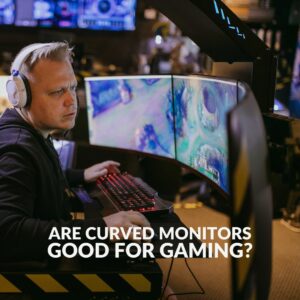
If you’re unsure if a curved monitor is good for gaming, our dedicated guide answers every question you’ve ever had about gaming on a curved monitor.
Small Monitors:
Small monitors are the perfect choice for gamers who don’t want a big hefty screen. Instead, you can opt for multiple small screens.
4K Monitors:
4K monitors, also known as UHD (Ultra High Definition) feature up to 3840 x 2160 resolutions to deliver stunning photo-realistic visuals. Compared to traditional 1080p monitors, a 4K display boasts a huge surface area for effortless multitasking to boost your productivity. What’s more, the high pixel density offers vivid and immersive visuals, especially when paired with built-in features such as HDR, or G-Sync and FreeSync.
Refresh Rates:
A phrase you often hear whilst talking about gaming monitors is ‘’refresh rates’’.
Refresh rates are measured in hertz (Hz) and simply refers to the number of times your monitor refreshes and redraws pixels per second. High refresh rates offer you a notable performance boost since you see all the high-speed gaming action quicker.
The most common refresh rates you’ll see when shopping for a gaming monitor include:
- 60Hz
- 120Hz
- 144Hz
- 240Hz
- 360Hz
Connectivity:
There are multiple different video connectivity options available, including HDMI, USB, DVI, and DisplayPort.
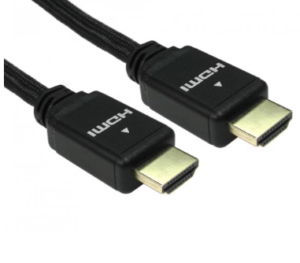
HDMI:
HDMI (High-Definition Multimedia Interface) is the most common type of connector. Televisions, gaming PCs, and consoles will most likely feature a HDMI port. HDMI includes support for both audio and video, making it a perfect all-round choice and easy to set up. Plus, for gamers, HDMI 2.0 can support up to 60 FPS at max 4K resolutions for incredible immersive gaming.
USB:
You can also opt to connect your monitor via a USB, typically a Thunderbolt-C cable. USB compatible monitors are quickly becoming more popular. USB is a widely used, universal connector. Your phones, consoles, laptops, and PC all come with one or more USB ports, so chances are you’ve already got a spare USB cable laying around. What’s more, USB connectively offers greater support for higher resolutions and refresh rates. In fact, Thunderbolt-C is capable of supporting 4K at 144Hz and even 8K at 60Hz.
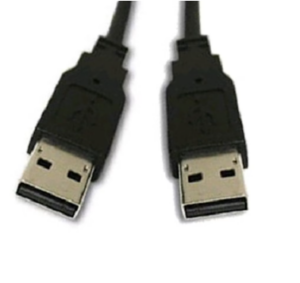
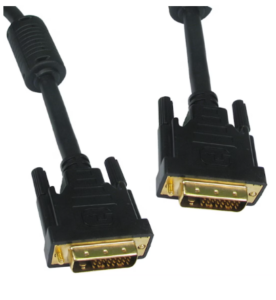
DVI:
DVI, or Digital Visual Interface, isn’t widely seen today but can still be found on some monitors. DVI only supports video, they don’t come equipped with support for audio. There are multiple different types of DVI connectors, such as DVI-A, DVI-D, and DVI-I. With a DVI cable, you can enjoy a steady 144Hz refresh rate at up to 1080p resolutions.
DisplayPort:
Alternatively, you can also use DisplayPort. DisplayPort connectors also support both audio and video, along with compatibility with Multi-Stream Transport (MST). This allows you to display your screen across multiple different monitors. DisplayPort is also better suited to gamers, since it is compatible with both AMD FreeSync and G-Sync. It can support for up to 8K max resolutions with up to 120Hz refresh rates.
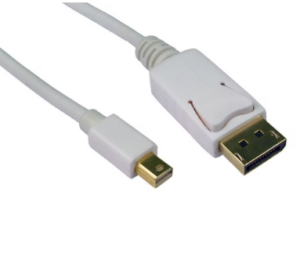
Multiple Monitor Set-Ups:
Speaking of multiple monitor set ups, these can be especially beneficial for both gamers and professionals.

As a gamer, having a second or third screen means you can have your game on one, your teammates chatting over Discord on the other, and an in-depth guide to whatever game you’re currently playing. The perfect combination to optimise your gaming experience. You won’t have to worry about breaking your immersion by having to check your game guides or to check Discord.
Moreover, for professionals, a multiple monitor set up can significantly improve your productivity. You can spread your workload, applications, and tabs across all your screens, removing the need for you to consistently flick between different windows.
Built-in Features:
Most gaming monitors come equipped with a vast array of cutting-edge features, designed to optimise performance and immersion. This includes support for either G-Sync or FreeSync, colour accuracy technology, adaptive brightness, and much more!
G-Sync:
G-Sync is NVIDIA’s own branded display technology. G-Sync has been designed work in tandem with your NVIDIA graphics cards, to ensure stunning visuals with virtually no screen tearing or stuttering. NVIDA G-Sync only works with NVIDIA graphics cards and requires a DisplayPort cable.
FreeSync:
FreeSync is AMD’s adaptative screen technology. It allows your GPU or APU to directly control the refresh rate of your monitor, to reduce screen tearing and input lag. You can use FreeSync on both NVIDIA and AMD graphics cards. It is also compatible with both HDMI and DisplayPort cables.
Our Top Gaming Monitors:
MSI G2422C 24’’ Widescreen Curved Gaming Monitor:
Level up your gaming performance with the MSI G2422C 24’’ Gaming Monitor. Utilise the VA 1920 x 1080 resolution, up to 170Hz refresh rates and 1ms response time for ultra-fast gaming and smooth frame rates. Take advantage of the three-sided borderless design, for a seamless display that is perfect for multiple monitor set ups.
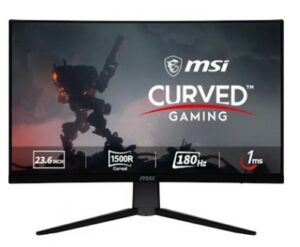
- 24” gaming monitor
- IPS panel
- 1920 x 1080 display resolution
- 170Hz refresh rates
- 1ms response time
ASUS TUF Gaming VG27VH1B 27’’ Curved Gaming Monitor:
The ASUS TUF Gaming 27’’ Curved Gaming Monitor is the perfect addition to any gaming set up. Utilise the VA 1920 x 1080 display, with up to 165Hz refresh rates for seamless performance, ultra-fast response times and smooth frame rates. Perfect for both work and play! What’s more, this monitor comes equipped with built-in support for AMD FreeSync and ASUS Extreme Low Motion Blur (ELMB) technology. Both of which results in near-zero screen tearing and ghosting, for high-definition visuals.
As a curved gaming monitor, the ASUS TUF VG27VH1B features a 1500R curvature for a greater viewing angle and improved comfort.
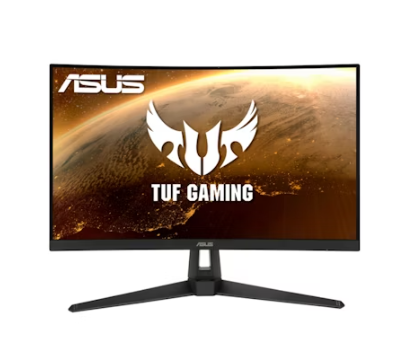
- 27” gaming monitor
- VA panel
- 1920 x 1080 display resolution
- 165Hz refresh rates
- 1ms response time
Samsung Odyssey G5 34” Ultrawide Gaming Monitor:
Boost your gaming and productivity with the Samsung Odyssey G5 34” Gaming Monitor. Ultrawide, this gaming monitor has been built utilising an VA panel with a 3440 x 1440 resolution and up to 165Hz refresh rates to unlock high-res visuals and ultra-fast response times.What’s more, take advantage of the hefty ultrawide screen size to boost your productivity with seamless multitasking.
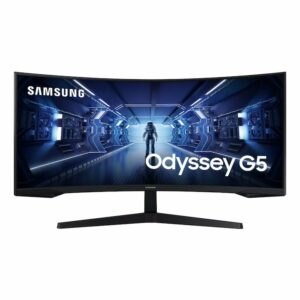
- 34” ultrawide monitor
- VA panel
- 3440 x 1440 display resolution
- 165Hz refresh rate
- 1ms response time
Optional Accessories
What’s more, you can also pair your gaming monitor with a range of accessories to streamline your set up and enhance your ergonomics. This includes a monitor mount or arm.
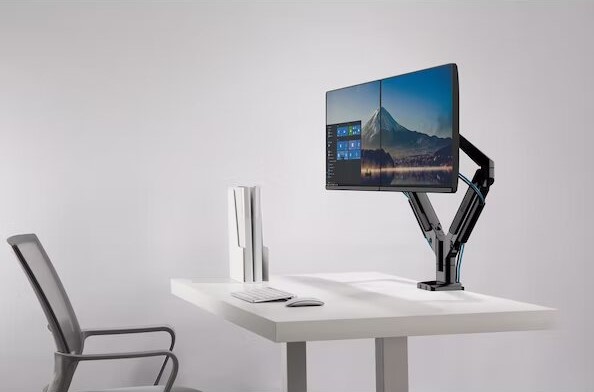
A monitor arm allows you to freely customise the height of your monitor, to ensure it suits your individual preferences. This allows you to keep your monitor at or just below your eye level to effectively reduce strain on your eyes and neck.
Investing in a monitor riser also frees up precious desk space, making more space for all your must-have peripherals, accessories, and of course your cuppa.
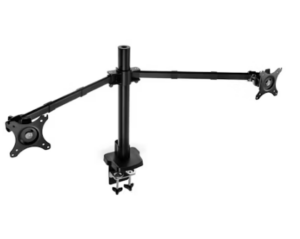
Kolink Chimera Dual Monitor Desk Mount:
- Dual monitor desk mount
- Can support up to 12kg per arm
- Integrated cable management
- Adjustable height and swivel
Our In-depth Guides to Your Gaming Set-Up:
From your monitor to your gaming desk – selecting the perfect components for your set up can be a challenging task. But that’s why we’ve created a series of dedicated guides, covering all the key features you need to look for, and our top recommendations!

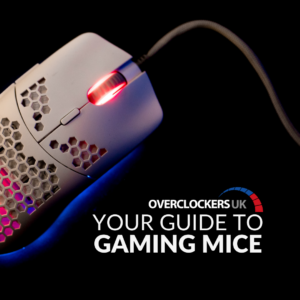
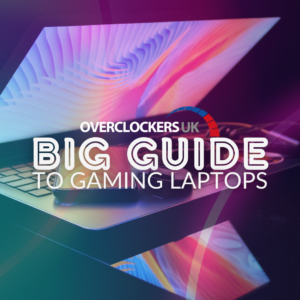
Your Choice of Gaming Monitor?
We’d love to hear what gaming monitor you’ve selected for your set up and why – let us know in the comments below.

